Physical Address
304 North Cardinal St.
Dorchester Center, MA 02124
Physical Address
304 North Cardinal St.
Dorchester Center, MA 02124
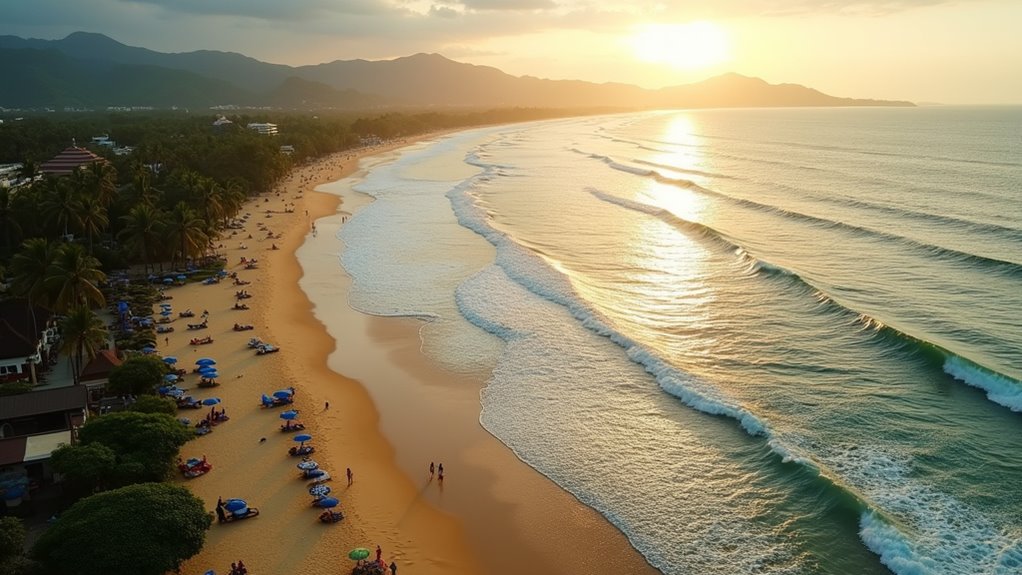
Packed with lifesaving evacuation routes and warning signs, this guide reveals which popular Bali beaches put you at highest tsunami risk.
When visiting Bali’s stunning beaches, you’re also entering potential tsunami zones that require your awareness. You’ll need to recognize warning signs like sudden ocean retreat and know exactly where to go when minutes count. The island’s most popular spots like Kuta and Seminyak face the highest risks, yet most travelers remain unprepared. Your safety depends on understanding evacuation routes, vertical shelters, and emergency protocols before disaster strikes. What’s your tsunami escape plan?
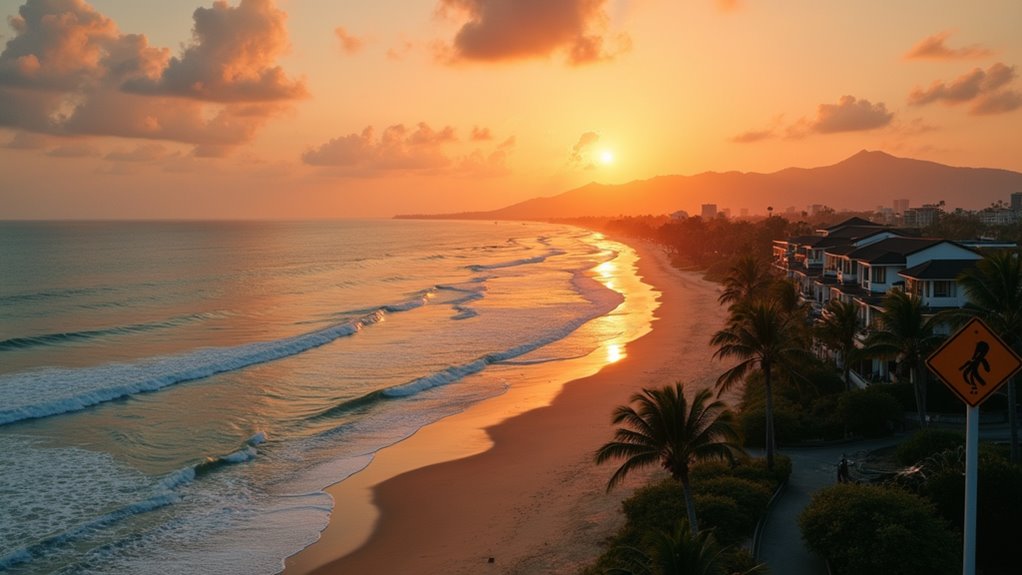
While many visitors come to Bali for its pristine beaches, few understand the complex tsunami risk zones that scientists have meticulously mapped across the island. These maps divide coastal areas into three primary hazard levels based on potential wave heights: high (>3m), moderate (1-3m), and low (<1m).
The island faces different threats depending on location. Southern coastlines including Kuta and Denpasar could experience waves under 10m but with minimal warning time. Official evacuation maps for Kuta and Sanur provide crucial evacuation routes to guide both travelers and residents to safety during tsunami events.
Northern Bali confronts dangers from the Flores Thrust, capable of generating powerful Mw 7.9+ earthquakes and resulting tsunamis.
Eastern shores have their own distinct risk profile. For those seeking sunset views, popular beach bars along the coast offer breathtaking scenery but visitors should remain aware of their proximity to tsunami danger zones.
Local bathymetry and coastal topography markedly influence tsunami behavior, creating variable inundation patterns that experts have modeled through hundreds of simulations.
Despite their postcard-perfect appearance, several popular Bali beach destinations sit squarely within high-risk tsunami zones that demand your vigilance.
Bali’s most beautiful beaches often hide the island’s most dangerous tsunami risk zones.
Kuta, Legian, Seminyak, and Sanur face the most severe threat, with potential waves exceeding 3 meters in worst-case scenarios. The Nusa islands (Penida, Lembongan, and Ceningan) are particularly vulnerable due to their coastal topography and limited evacuation routes.
Sanur’s low-lying geography makes it a critical concern, while Denpasar’s coastal suburbs present evacuation challenges due to high population density.
Uluwatu and Jimbaran face threats from multiple fault lines, with Jimbaran Bay’s shallow waters potentially amplifying waves. Being part of the Sunda Arc region, Bali is especially susceptible to earthquake-triggered tsunamis that can develop with little warning time.
Even “safer” areas like Candidasa and Padang Bai remain exposed to moderate risks, with projected waves of 1-3 meters possible during major events. For maximum safety while visiting these areas, familiarize yourself with the Island of Gods evacuation routes and warning systems in advance.
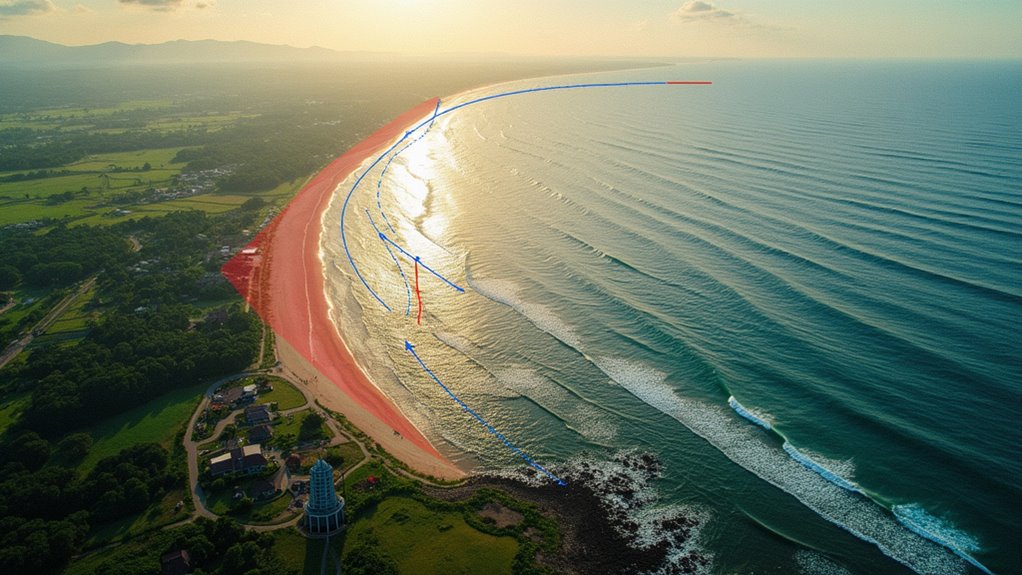
Recognizing tsunami warning signs could save your life when visiting Bali’s coastal areas. Both natural indicators and official warning systems provide vital alerts that require immediate action.
Pay attention to these essential warning signs:
Remember that Bali’s warning system includes mobile alerts, local broadcasts, and community loudspeakers.
If you’re in a flat area like Tanjung Benoa, find a building at least 3 stories tall for vertical evacuation.
You’ll have only 15-20 minutes to reach safety after warnings are issued.
Tsunami waves can travel much further inland than regular ocean waves due to their long wavelength, making evacuation to higher ground critical.
Visitors should familiarize themselves with tsunami evacuation routes before traveling to coastal areas in Bali.
Knowing where to go once a tsunami warning occurs is just as important as recognizing the warning signs. If you’re in high-risk areas like Kuta, Tanjung Benoa, Sanur, Kendongan, Seminyak, or Nusa Dua, you’ll need to act quickly when sirens sound their three-minute wail.
When tsunami warnings sound, swift action in high-risk areas could mean the difference between life and death.
In red zones (closest to coastlines), you have approximately 15-20 minutes to evacuate. Tanjung Benoa residents should prioritize vertical evacuation due to its flat terrain.
For other areas, immediately move inland toward higher ground following designated evacuation routes. The visual guides provided on tsunami evacuation maps will direct you to the nearest safe zones.
Always familiarize yourself with tsunami hazard maps before an emergency occurs. Identify multiple evacuation routes from your location, as traffic congestion may block primary paths. While Jakarta offers thrilling activities, Bali’s coastal areas require vigilant preparation for natural disasters.
Remember that sirens mightn’t reach all areas, so don’t rely solely on official warnings to trigger your evacuation.

When tsunami warning times are critically short, vertical evacuation becomes your only viable option for survival. In Bali’s high-risk zones, identify nearby sturdy concrete or steel-reinforced buildings that can withstand powerful wave forces.
Look for these critical features in a vertical shelter:
The minimum recommended space is 1 m² per evacuee to ensure adequate room during emergency sheltering situations.
Remember that hotels, shopping centers, and government buildings in tsunami-prone areas of Bali are increasingly being designed with evacuation safety in mind.
Familiarize yourself with these structures during non-emergency times and participate in local evacuation drills whenever possible.
When visiting the Island of Gods, be sure to balance your enjoyment of paradise with awareness of safety measures.
Because tsunami events can strike with minimal warning, a well-stocked emergency kit becomes your lifeline during coastal stays in Bali. Pack essential first aid supplies including bandages, antiseptic wipes, pain relievers, and antihistamines for allergic reactions.
For Bali’s tropical environment, include mosquito repellent, insect sting treatments, and high SPF sunscreen. Plus, pack antivenom treatment options if you plan to explore areas where dangerous animals are commonly found. Don’t forget water purification tablets, collapsible bottles, and biodegradable soap for hygiene maintenance. Consider bringing a mosquito-proof bed net for protection during potential evacuation scenarios in remote rural areas.
Communication tools are vital—pack portable chargers, flashlights with extra batteries, and a whistle for signaling. Two-way radios provide communication when cell networks fail.
Always carry copies of important documents: emergency contacts, travel insurance, and identification. Include evacuation maps marked with escape routes and assembly points specific to your location in Bali’s coastal areas.
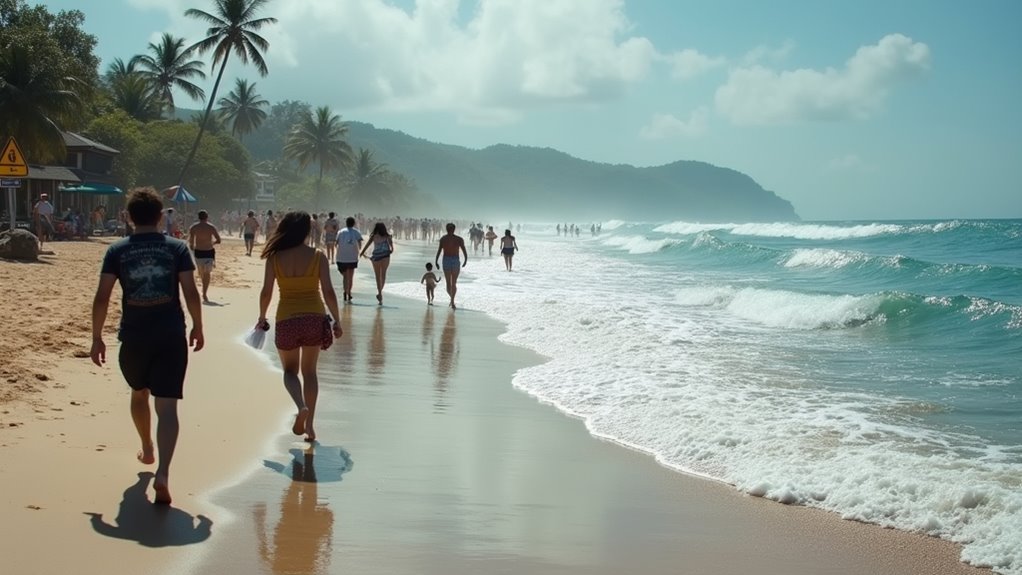
While your emergency kit guarantees preparedness, your immediate actions after feeling an earthquake can determine your survival in Bali’s coastal areas. Remember that earthquakes often precede tsunamis, so your response must be swift and methodical.
In Bali’s coastal regions, your post-earthquake actions may save your life when minutes matter most before potential tsunamis arrive.
When the ground starts shaking:
Once the shaking subsides, quickly assess your surroundings for hazards like exposed wiring or gas leaks. Look for natural tsunami signs such as unusual water retreat or loud ocean roars that may indicate an approaching tsunami.
If you’re in a restaurant enjoying Balinese cuisine, remain calm and follow the hotel’s evacuation procedures rather than rushing to finish your meal.
If you’re near the coast, don’t wait for official warnings—immediately move to higher ground.
Reuniting with family members during or after a tsunami emergency requires strategic planning that begins long before disaster strikes. Establish a designated meeting point on high ground that’s accessible to all family members, regardless of their starting location.
Create a communication tree with multiple contact methods, as cell networks may fail during emergencies. Assign each family member a buddy to check in with, especially for elderly relatives or children. Store digital copies of everyone’s identification documents in a secure cloud location accessible to trusted family members.
Consider forming a small planning committee with clear roles if your family is large. Pre-program local emergency numbers into everyone’s phones and distribute waterproof emergency contact cards. Always maintain a contingency fund specifically for emergency transportation and accommodation needs. In the event of extended displacement, be aware of visa options and legal stay limitations affecting your family’s ability to remain together during recovery. Based on research showing over half of family reunions require six months to a year of advance planning, apply this same timeframe to developing your emergency reunion strategy.
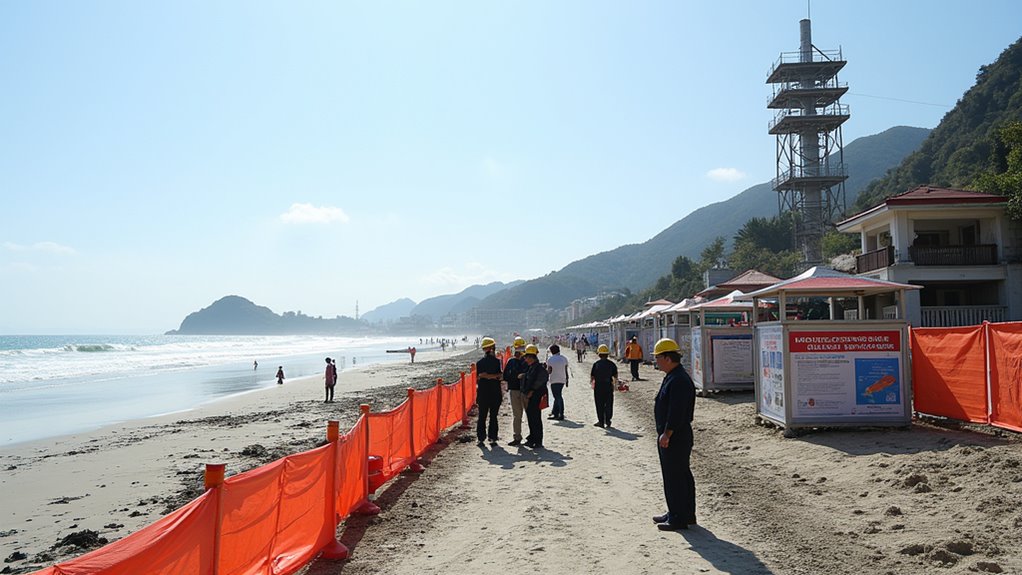
After a tsunami subsides, you’ll face critical recovery challenges that require specific resources and safety protocols. Indonesia’s recovery infrastructure includes community-based housing programs, health facility restoration, and land title recovery systems to help you rebuild your life.
When steering through post-tsunami environments, prioritize:
Following the 2004 Indian Ocean tsunami, Indonesia established the Build Back Better philosophy which now guides all reconstruction efforts to ensure stronger resilience against future disasters.
If you’re staying in Bali, consider visiting Nusa Dua where luxury resorts have implemented some of the island’s most comprehensive tsunami evacuation protocols.
Like a well-prepared surfer who reads the ocean before paddling out, you’re now equipped to navigate Bali’s tsunami risks. With 83% of tsunami deaths preventable through proper preparation, your awareness is your strongest defense. Remember: recognize warning signs, know your evacuation routes, and maintain your emergency kit. Don’t hesitate—a tsunami waits for no one. Your vigilance today guarantees tomorrow’s stories won’t be tales of regret.